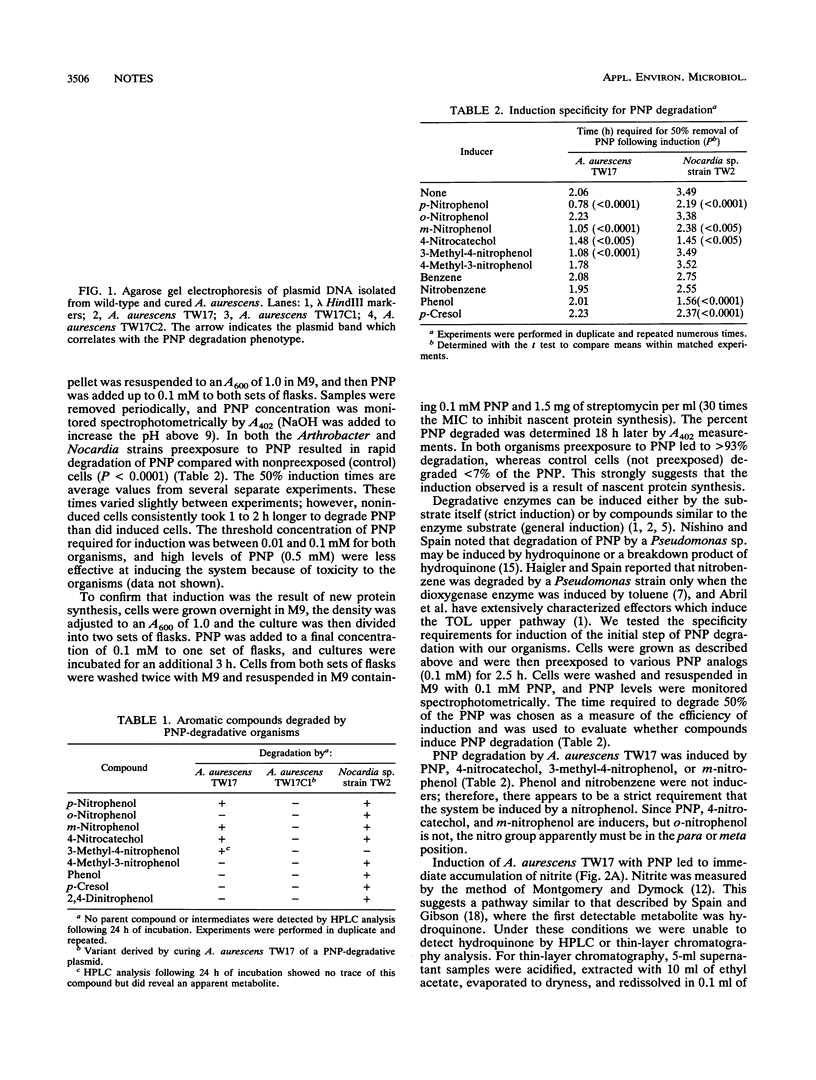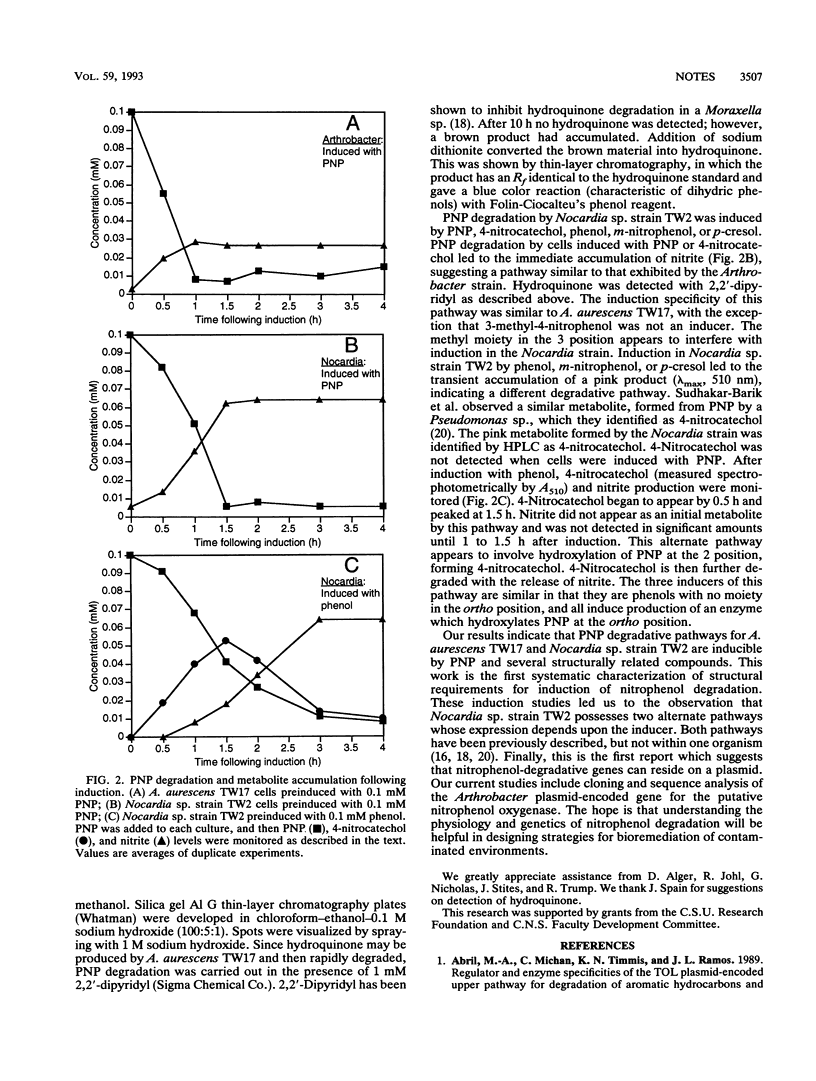Abstract
We have isolated two soil bacteria (identified as Arthrobacter aurescens TW17 and Nocardia sp. strain TW2) capable of degrading p-nitrophenol (PNP) and numerous other phenolic compounds. A. aurescens TW17 contains a large plasmid which correlated with the PNP degradation phenotype. Degradation of PNP by A. aurescens TW17 was induced by preexposure to PNP, 4-nitrocatechol, 3-methyl-4-nitrophenol, or m-nitrophenol, whereas PNP degradation by Nocardia sp. strain TW2 was induced by PNP, 4-nitrocatechol, phenol, p-cresol, or m-nitrophenol. A. aurescens TW17 initially degraded PNP to hydroquinone and nitrite. Nocardia sp. strain TW2 initially converted PNP to hydroquinone or 4-nitrocatechol, depending upon the inducing compound.
Full text
PDF



Selected References
These references are in PubMed. This may not be the complete list of references from this article.
- Brandsch R., Decker K. Isolation and partial characterization of plasmid DNA from Arthrobacter oxidans. Arch Microbiol. 1984 May;138(1):15–17. doi: 10.1007/BF00425400. [DOI] [PubMed] [Google Scholar]
- Bruhn C., Lenke H., Knackmuss H. J. Nitrosubstituted aromatic compounds as nitrogen source for bacteria. Appl Environ Microbiol. 1987 Jan;53(1):208–210. doi: 10.1128/aem.53.1.208-210.1987. [DOI] [PMC free article] [PubMed] [Google Scholar]
- Delgado A., Wubbolts M. G., Abril M. A., Ramos J. L. Nitroaromatics Are Substrates for the TOL Plasmid Upper-Pathway Enzymes. Appl Environ Microbiol. 1992 Jan;58(1):415–417. doi: 10.1128/aem.58.1.415-417.1992. [DOI] [PMC free article] [PubMed] [Google Scholar]
- Haigler B. E., Pettigrew C. A., Spain J. C. Biodegradation of mixtures of substituted benzenes by Pseudomonas sp. strain JS150. Appl Environ Microbiol. 1992 Jul;58(7):2237–2244. doi: 10.1128/aem.58.7.2237-2244.1992. [DOI] [PMC free article] [PubMed] [Google Scholar]
- Haigler B. E., Spain J. C. Biotransformation of nitrobenzene by bacteria containing toluene degradative pathways. Appl Environ Microbiol. 1991 Nov;57(11):3156–3162. doi: 10.1128/aem.57.11.3156-3162.1991. [DOI] [PMC free article] [PubMed] [Google Scholar]
- Heitkamp M. A., Camel V., Reuter T. J., Adams W. J. Biodegradation of p-nitrophenol in an aqueous waste stream by immobilized bacteria. Appl Environ Microbiol. 1990 Oct;56(10):2967–2973. doi: 10.1128/aem.56.10.2967-2973.1990. [DOI] [PMC free article] [PubMed] [Google Scholar]
- Miller L. T. Single derivatization method for routine analysis of bacterial whole-cell fatty acid methyl esters, including hydroxy acids. J Clin Microbiol. 1982 Sep;16(3):584–586. doi: 10.1128/jcm.16.3.584-586.1982. [DOI] [PMC free article] [PubMed] [Google Scholar]
- Munnecke D. M. Enzymatic hydrolysis of organophosphate insecticides, a possible pesticide disposal method. Appl Environ Microbiol. 1976 Jul;32(1):7–13. doi: 10.1128/aem.32.1.7-13.1976. [DOI] [PMC free article] [PubMed] [Google Scholar]
- Spain J. C., Gibson D. T. Pathway for Biodegradation of p-Nitrophenol in a Moraxella sp. Appl Environ Microbiol. 1991 Mar;57(3):812–819. doi: 10.1128/aem.57.3.812-819.1991. [DOI] [PMC free article] [PubMed] [Google Scholar]
- Stevens T. O., Crawford R. L., Crawford D. L. Selection and isolation of bacteria capable of degrading dinoseb (2-sec-butyl-4,6-dinitrophenol). Biodegradation. 1991;2(1):1–13. doi: 10.1007/BF00122420. [DOI] [PubMed] [Google Scholar]
- Sudhakar-Barik, Siddaramappa R., Wahid P. A., Sethunathan N. Conversion of p-nitrophenol to 4-nitrocatechol by a Pseudomonas sp. Antonie Van Leeuwenhoek. 1978;44(2):171–176. doi: 10.1007/BF00643219. [DOI] [PubMed] [Google Scholar]


